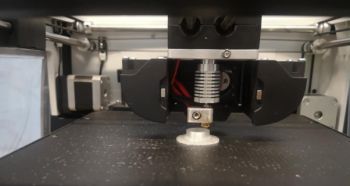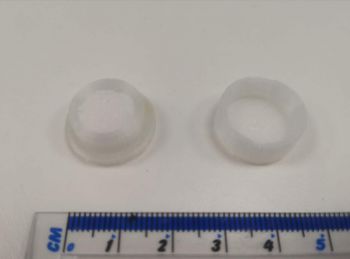Central to the treatment of most patients, medication in the form of pills and complex drug delivery systems is expected to change drastically in the coming years too as these items can be 3D printed quickly, affordably, and in a variety of shapes, sizes, and colors—moving from the conceptual stage to reality with the FDA approval of Aprecia, an epilepsy pill. The trend has continued from there, and although perhaps a bit more slowly than expected, many researchers continue to make strides.
Now, engineers and pharmaceutical scientists from the University of Sussex and the University of Texas at Austin have created a unique method for drug delivery, featuring remote control. 3D-printed pills, in capsule form, are controlled by magnetic fields and triggered for drug delivery to patients as needed. This could mean improved treatment for patients with serious diseases:
“The device delivers enhanced efficacy and safety through optimal drug distribution and absorption in the targeted location at the (sub)cellular level. This device has the potential to be used in treatments for cancer, diabetes, pain, and myocardial infarction which require variable release kinetics where patients’ suffer from discomfort or inconvenience if they currently rely on untunable monotonic drug treatment,” said Professor Ali Nokhodchi, head of Pharmaceutics Research Lab at the University of Sussex School of Life Sciences and corresponding author.
With the use of magnets, as outlined in “Novel 3D printed device with integrated macroscale magnetic field triggerable anti-cancer drug delivery system,” medication could be directed toward areas requiring drug delivery, and then applied closely.
“The device offers the potential for personalized treatment through the loading of a given drug in a particular concentration and releasing it within different dosage patterns. All results confirmed that the device can provide a safe, long-term, triggerable and reutilizable way for localized disease treatments such as cancer,” said Kejing Shi, doctoral researcher in the University of Sussex’s School of Life Sciences and lead author of the study.
Such targeted delivery could allow patients to forego aggressive treatments like chemotherapy, not only weakening patients but also harming other cells. Errors in dosing could be eliminated also—one of the major reasons for bad side effects.
“Advancing this process further, we could create different compartments in the capsule with different sponges or employ other techniques where the macroporous sponge properties can be tailored to hold two or more substances without being mixed which could deliver more complex courses of treatment,” said Dr. Rodrigo Aviles-Espinosa.
What do you think of this news? Let us know your thoughts! Join the discussion of this and other 3D printing topics at 3DPrintBoard.com.
[Source / Images: University of Sussex]Subscribe to Our Email Newsletter
Stay up-to-date on all the latest news from the 3D printing industry and receive information and offers from third party vendors.
Print Services
Upload your 3D Models and get them printed quickly and efficiently.
You May Also Like
Reinventing Reindustrialization: Why NAVWAR Project Manager Spencer Koroly Invented a Made-in-America 3D Printer
It has become virtually impossible to regularly follow additive manufacturing (AM) industry news and not stumble across the term “defense industrial base” (DIB), a concept encompassing all the many diverse...
Inside The Barnes Global Advisors’ Vision for a Stronger AM Ecosystem
As additive manufacturing (AM) continues to revolutionize the industrial landscape, Pittsburgh-based consultancy The Barnes Global Advisors (TBGA) is helping shape what that future looks like. As the largest independent AM...
Ruggedized: How USMC Innovation Officer Matt Pine Navigates 3D Printing in the Military
Disclaimer: Matt Pine’s views are not the views of the Department of Defense nor the U.S. Marine Corps Throughout this decade thus far, the military’s adoption of additive manufacturing (AM)...
U.S. Congress Calls Out 3D Printing in Proposal for Commercial Reserve Manufacturing Network
Last week, the U.S. House of Representatives’ Appropriations Committee moved the FY 2026 defense bill forward to the House floor. Included in the legislation is a $131 million proposal for...



































